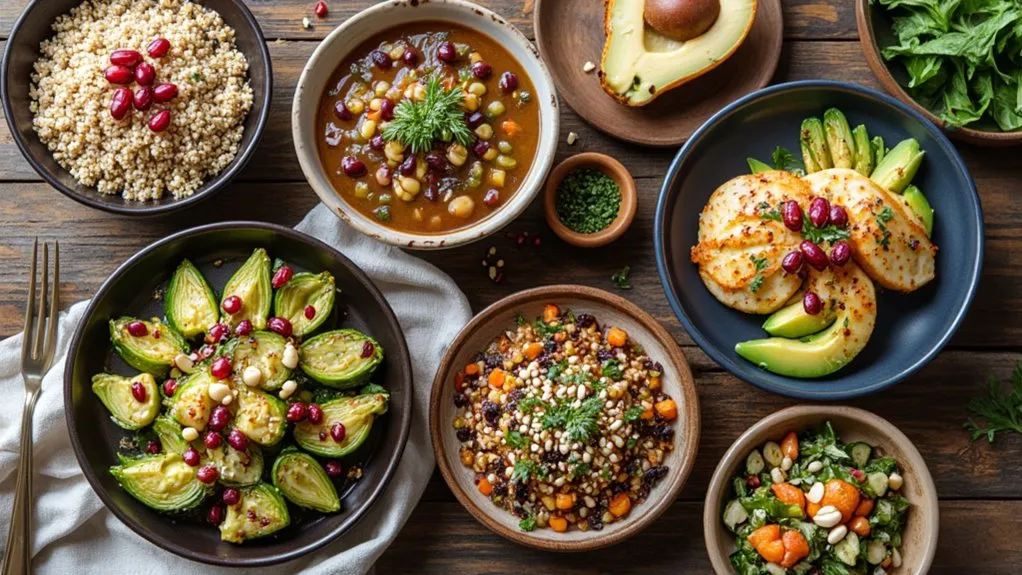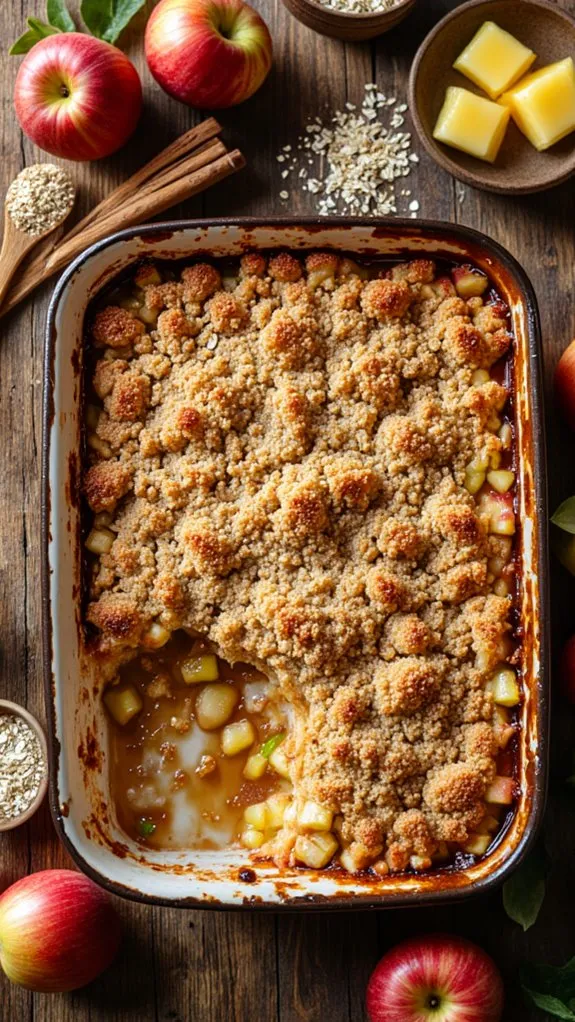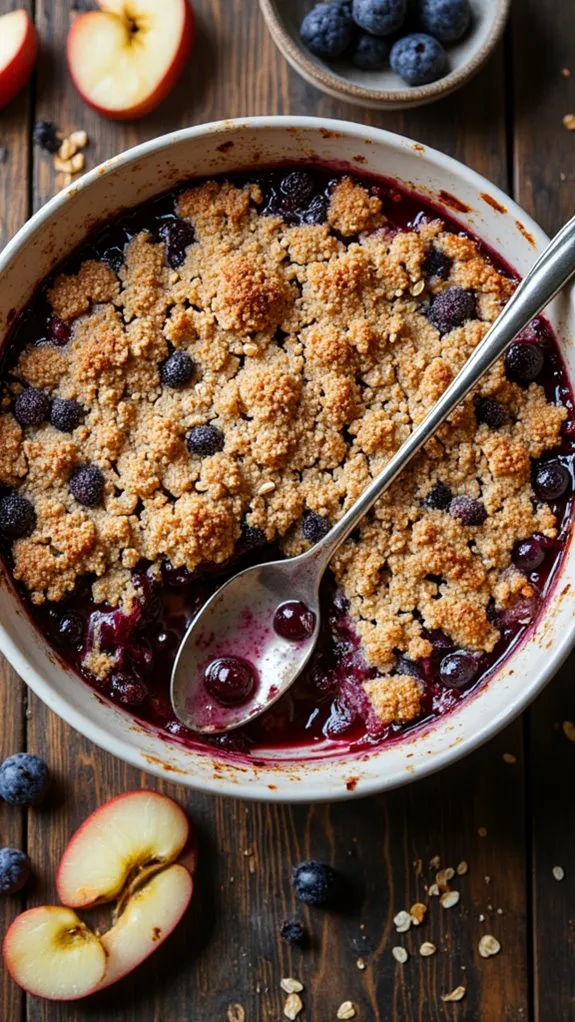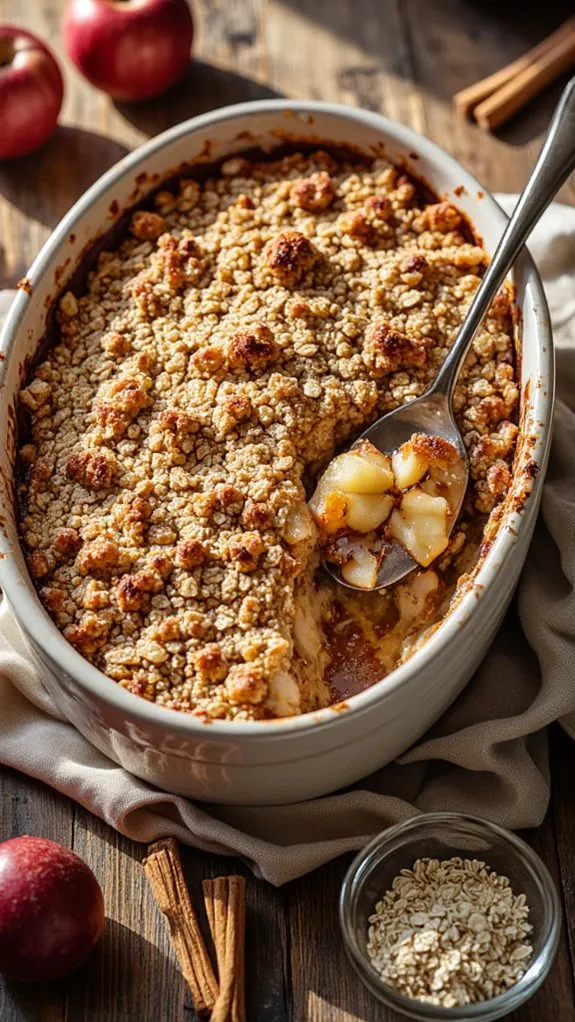I’ve tested these twenty-three recipes, and here’s what I found: fiber doesn’t have to mean bland or heavy. You’re getting bright, tangy flavors—think lemon-garlic brightness, herb-forward seasoning, and quality fats that actually satisfy. Canned beans and whole grains form the backbone, sure, but the real magic happens when you layer citrus and fresh herbs. Your digestion benefits, you stay fuller longer, and meals come together fast. But which recipes deliver the best bang for your effort?
5-Ingredient Avocado & Chickpea Salad

If you’re looking to boost your fiber intake without cranking up the stove, I’d lean toward this no-cook salad—it’s genuinely one of those recipes that punches way above its weight.
Creamy avocado paired with hearty chickpeas delivers 6+ grams of fiber per serving in under 25 minutes. It’s plant-based protein done right.
Customize with citrus and fresh herbs to make it your own. Serve over greens or whole-grain bread for a genuinely satisfying meal that works for lunch, dinner, or meal prep throughout the week.
Click here to view the complete recipe with ingredients, step-by-step instructions, and full nutrition facts.
No-Chicken Salad Sandwich

Build this one up and you’ve got a plant-powered lunch that’ll convince anyone that chickpeas belong in a salad sandwich. I smash canned chickpeas with mayo, celery, and onion, then add lemon juice for tang. Serve it on whole-grain bread for 6+ grams of fiber per serving. You’ll get protein, texture mimicking chicken salad, and a satisfying meal ready in under 25 minutes.
The beauty of this no-chicken salad is its versatility—add diced apples for sweetness, fresh herbs for brightness, or grapes for extra juiciness. A dollop of Dijon mustard brings sophisticated depth, while the creamy mayo binds everything together. Enjoy it as a classic sandwich on whole-grain bread, wrapped in a tortilla for easy eating, or spooned over crisp salad greens for a lighter option.
It’s also perfect for meal prep since the flavors actually improve after sitting in the fridge for a day.
Click through to get the complete recipe with full ingredient measurements, step-by-step instructions, and detailed nutrition information.
High-Protein Tuna & Chickpea Salad Sandwich

Combine canned tuna with smashed chickpeas and you’ve got a sandwich filling that punches way harder on protein and fiber than either ingredient alone. I layer in garlic and Sriracha for depth and binding power.
Whole-grain bread seals the deal—you’re looking at 6+ grams of fiber per serving.
This recipe comes together in under 25 minutes and stores beautifully when you keep filling separate from bread. The chickpeas add a creamy texture while boosting the protein content significantly, making this sandwich perfect for meal prep or a quick lunch that will actually keep you full.
Click through to get the complete ingredient list, step-by-step instructions, and full nutrition information.
Chickpea Chopped Salad With Pita Chips

While that tuna sandwich nails the protein-and-fiber combo in a handheld format, sometimes you want something you can actually see—where every ingredient earns its place on the plate.
I’ve found chickpeas, cucumber, tomato, feta, and olives create genuine texture contrast. Whole-wheat pita chips add crunch and fiber. Ready in 25 minutes, it’s genuinely satisfying solo or paired with grilled protein for balance.
This salad delivers on convenience without sacrificing nutrition.
The chickpeas bring plant-based protein and fiber that keep you full, while the vegetables add vitamins and minerals. The feta provides calcium and tang, and those crispy pita chips turn what could be just another boring bowl into something with real staying power.
It’s the kind of lunch that doesn’t leave you hunting through the pantry an hour later.
Click here to get the complete recipe with full ingredients list, step-by-step instructions, and detailed nutrition information.
White Bean Salad With Feta & Lemon-Garlic Vinaigrette

If you’re after a salad that actually fills you up, white beans are your answer. I pair them with creamy feta and a bright lemon-garlic vinaigrette that cuts through richness beautifully. Toasted walnuts add crunch and healthy fats. It’s ready in 25 minutes, stores perfectly for meal prep, and works as a standalone lunch or grain bowl topper.
This no-cook recipe is all about simplicity and fresh flavors. You’ll drain and rinse your beans, crumble the feta, whisk together a tangy vinaigrette with fresh lemon juice and minced garlic, then toss everything together with your choice of greens and herbs. The result is a protein-packed salad that actually tastes incredible and keeps you satisfied for hours.
Click below to get the complete recipe with ingredient measurements, step-by-step instructions, and full nutrition information!
No-Cook White Bean & Spinach Caprese Salad

The white bean salad I just shared proves beans belong in every lunch rotation, but here’s what happens when you swap the vinaigrette-heavy approach for something brighter: you get a caprese-inspired bowl that tastes like summer on a plate.
This no-cook version combines protein-rich white beans with fresh spinach, juicy tomatoes, creamy mozzarella, and fragrant basil for a meal that requires zero time at the stove.
The beauty of this salad lies in its simplicity and speed. Drain your canned beans, toss them with fresh spinach leaves, halved cherry tomatoes, torn mozzarella, and ribbons of basil, then finish with a drizzle of lemon-garlic or balsamic vinaigrette.
Pair it with toasted whole-grain bread to boost your fiber intake, and you’ve got a complete meal ready in 10–15 minutes that’s also make-ahead friendly for busy weekdays.
Click here to see the full recipe with exact measurements, step-by-step instructions, and complete nutrition information.
Brothy Lemon-Garlic Beans

Swap your heavy vinaigrettes for something that’ll warm you from the inside out—this lemon-garlic broth transforms humble canned beans into a deeply satisfying bowl that comes together in under 25 minutes. The slow cooker does all the work while you go about your day, infusing every bean with aromatic garlic and bright citrus notes.
You’re getting 6–10 grams of fiber per serving, plus plant protein that keeps you full.
Simply combine your beans, broth, smashed garlic cloves, and lemon zest in the slow cooker and let it work its magic on low for 3–4 hours. The gentle heat allows the flavors to meld beautifully without any effort on your part.
Finish with fresh lemon juice and herbs for brightness that cuts through the creamy base beautifully—it’s comfort food that actually nourishes you.
Click through for the complete recipe with exact measurements and step-by-step slow cooker instructions.
Marry Me White Bean & Spinach Skillet

You’ll fall for this creamy skillet the moment it hits the table—it’s a vegetarian riff on that viral “Marry Me Chicken” that swaps poultry for fiber-packed white beans and pulls together in 25 minutes. The magic happens in a single pan where garlic-infused olive oil meets sun-dried tomatoes, creating an aromatic base before white beans and fresh spinach join the party.
A luxurious cream sauce spiked with parmesan and Italian herbs transforms humble pantry staples into something restaurant-worthy.
This weeknight wonder delivers serious satisfaction without the meat. Canned white beans bring concentrated protein and fiber to keep you full, while baby spinach wilts down in minutes, adding vitamins without extra fuss.
The velvety sauce practically begs you to soak it up with crusty whole-grain bread, making it a complete meal that feels indulgent but keeps things balanced. From stovetop to table in under 30 minutes, it’s the kind of dinner that earns repeat requests.
Click through for the complete recipe with full ingredient measurements, step-by-step instructions, and nutrition information.
White Bean Enchilada Skillet

When you’re craving that enchilada comfort but don’t have time for rolling and baking, this skillet version delivers the same bold, layered flavors in about 25 minutes. White beans anchor this one-pan meal with serious protein and fiber, while nestled tortillas soak up spiced sauce and melted cheese.
Layer spinach or peppers for extra nutrition without extra effort—that’s honest, satisfying cooking.
This straightforward skillet method means less cleanup and more time at the table. Everything comes together in one pan—you’ll build layers of seasoned beans, torn tortillas, enchilada sauce, and cheese, then let it all bubble until golden and irresistible.
It’s the kind of weeknight dinner that feels special without demanding much from you.
Click below to get the complete ingredient list, step-by-step instructions, and full nutrition information for this White Bean Enchilada Skillet.
Avocado Tuna Salad Sandwich

Canned tuna’s got a reputation for being bland and mayo-heavy, but here’s the truth: ripe avocado transforms it into something genuinely craveable.
You’ll get creamy richness, healthy fats, and serious fiber without the heaviness. This sandwich comes together in minutes with simple pantry staples and fresh ingredients that pack both flavor and nutrition.
The secret is in the combination: whole-grain bread adds 3–5g fiber per slice, while half an avocado delivers another 3–4g fiber along with heart-healthy monounsaturated fats.
Celery and red onion provide satisfying crunch and essential nutrients, creating layers of texture that keep every bite interesting.
Assemble just before eating to prevent sogginess and maintain that perfect contrast between crispy vegetables and creamy filling.
Click here to view the complete recipe with full ingredients list, step-by-step instructions, and detailed nutrition facts.
Salmon-Stuffed Avocados

Transform a ripe avocado into a protein-packed lunch by filling it with seasoned canned salmon—no cooking required. I mix the salmon with Greek yogurt instead of mayo for creaminess and extra protein without the saturated fat. Add lemon juice, fresh herbs, and diced onion for brightness. The combination creates a satisfying meal that’s both nutritious and convenient for busy days.
This recipe delivers roughly 20–25g protein and 6–10g fiber per serving, making it an excellent choice for a balanced lunch or light dinner. The natural fats from the avocado pair perfectly with the lean protein from the salmon, while the Greek yogurt adds a tangy richness. Assemble just before eating to prevent browning and enjoy the fresh, vibrant flavors at their peak.
Click here to view the complete recipe with full ingredient measurements, step-by-step instructions, and detailed nutrition information.
Cucumber-Spinach Sandwich

I’ll always reach for this sandwich when I need something that’s genuinely satisfying without firing up the stove—crisp cucumber slices and tender baby spinach layered on whole-grain bread create a lunch that delivers serious fiber (6–8g per sandwich) while keeping things light and refreshing.
The beauty of this recipe lies in its simplicity: fresh vegetables provide crunch and hydration, while whole-grain bread offers sustained energy and essential nutrients to keep you fueled throughout your afternoon.
Building the perfect cucumber-spinach sandwich is all about layering flavors and textures thoughtfully. Start with your choice of seeded or whole-grain bread, spread a generous layer of hummus or mashed avocado for creaminess and healthy fats, then pile on thinly sliced cucumbers, fresh baby spinach, and optional additions like radishes or shredded carrots.
A sprinkle of chia or flax seeds adds an extra fiber boost and subtle nutty flavor that elevates this simple sandwich into something truly nourishing.
Click through to get the complete recipe with exact measurements, step-by-step assembly instructions, and full nutrition information.
Cucumber-Avocado-Tomato Sandwich

When you layer creamy avocado, crisp cucumber, and juicy tomato on whole-grain bread, you’re building a sandwich that delivers real nutrition without compromise—roughly 13–15 grams of fiber, healthy fats, and enough flavor complexity to make you forget you’re eating something genuinely good for you.
This no-cook marvel comes together in minutes, making it perfect for busy lunches or light dinners when you want maximum nutrition with minimal effort.
The beauty of this sandwich lies in its simplicity and the quality of each component.
Whole-wheat bread provides sustained energy through complex carbohydrates, while avocado contributes heart-healthy monounsaturated fats and a full 7 grams of fiber per half.
The cucumber adds refreshing crunch and hydration, and tomato brings a burst of acidity along with lycopene, a powerful antioxidant.
Together, these humble ingredients create a satisfying meal that supports your wellness goals without sacrificing taste.
Click here to view the complete recipe with detailed ingredients, step-by-step instructions, and full nutrition facts.
Broccoli Melts

Pair crisp-tender broccoli with melted cheese on toasted whole-grain bread, and you’ve got a 20-minute sandwich that actually tastes like comfort food while delivering serious nutrition.
This simple recipe transforms humble ingredients into a satisfying meal that works equally well for lunch or dinner.
The combination of textures—crunchy toasted bread, tender broccoli florets, and gooey melted cheese—creates a sandwich that’s far more interesting than the sum of its parts.
Steaming the broccoli briefly preserves its vibrant color and crisp-tender texture while maximizing fiber retention.
Whole-grain bread boosts the fiber content and digestive benefits compared to white bread, while melted cheese adds calcium and protein for nutritional balance.
With just twenty minutes from start to finish, this recipe makes weeknight dinners genuinely feasible, even on your busiest days.
Click here to view the complete recipe with full ingredient measurements, step-by-step instructions, and detailed nutrition facts.
Raspberry-Spinach Salad With Avocado & Walnuts

Build this salad, and you’re looking at one of the easiest high-fiber meals that actually delivers on flavor—bright, tart raspberries cut through creamy avocado while toasted walnuts add genuine crunch and earthiness.
You’ll hit your daily fiber goals without trying. Toss in grilled chicken or quinoa, dress it with citrus, and you’ve got yourself a balanced lunch that keeps you full for hours.
This recipe comes together in minutes with minimal prep work, making it perfect for busy weeknights or meal prep Sundays.
The combination of textures and flavors means you won’t get bored halfway through, and the natural sweetness of the berries means you can go light on added dressing without sacrificing taste.
Click here to view the complete recipe with full ingredient measurements, step-by-step instructions, and detailed nutrition information.
Spinach Salad With Quinoa, Chicken & Fresh Berries

If you’ve got rotisserie chicken and a box of microwavable quinoa in your kitchen, you’re literally 15 minutes away from a salad that’ll keep you satisfied through dinner. This no-cook recipe is perfect for busy weeknights when you want something nutritious without turning on the stove. Simply combine your pre-cooked ingredients, toss with fresh greens and berries, and you’ve got a restaurant-quality meal ready to go.
The beauty of this salad lies in its balanced nutrition profile. Baby spinach and quinoa create a fiber powerhouse that helps stabilize blood sugar, while fresh berries add natural sweetness along with 2–4g of fiber per serving.
Shredded rotisserie chicken provides lean protein for lasting fullness, and a handful of nuts or seeds boosts the fiber content another 1–2g effortlessly. The combination keeps you energized and satisfied for hours.
Click here to view the complete recipe with full ingredients list, step-by-step instructions, and detailed nutrition facts.
Black Bean–Quinoa Bowl

Since you’re already sold on quinoa’s versatility, you’ll appreciate how it transforms into something entirely different when paired with black beans and bold toppings. I’m talking creamy avocado, zesty pico de gallo, and fresh cilantro—each bringing serious nutritional firepower. You’re looking at 8–12g fiber per serving, complete protein, and honest satisfaction.
This black bean–quinoa bowl comes together quickly and delivers maximum flavor with minimal effort. The combination of fluffy quinoa and hearty black beans creates a satisfying base that holds up beautifully under layers of fresh toppings.
Whether you’re meal-prepping for the week or need a fast weeknight dinner, this bowl checks every box.
Click here to view the complete recipe with full ingredient measurements, step-by-step instructions, and detailed nutrition information.
Vegan Superfood Grain Bowls

The beauty of grain-bowl architecture lies in its flexibility—you’re essentially stacking whole grains, legumes, and colorful vegetables into a nutrient-dense meal that tastes nothing like health food. Start with microwavable quinoa as your base to cut prep time down to just 15 minutes without sacrificing any of the fiber content your body craves.
Layer on red beets, orange sweet potato, and baby kale to create a rainbow of antioxidants that feeds your gut microbiome with every forkful.
Top your bowl with a generous handful of nuts and seeds, then drizzle with creamy tahini-based hummus dressing to deliver 8–12+ grams of fiber per serving. The key to maintaining this healthy habit is batch-prepping your grain and vegetable bases at the start of the week, ensuring high-fiber meals remain accessible even on your busiest days.
These bowls are endlessly customizable—swap ingredients based on what’s in season or what you have on hand, and you’ll never get bored.
Click through to get the complete recipe with full ingredient measurements, step-by-step instructions, and detailed nutrition facts.
Stuffed Sweet Potato With Hummus Dressing

Transform this fiber-rich meal into an effortless slow cooker dinner by letting your appliance do the work while you go about your day. Pierce your sweet potatoes several times with a fork, wrap them in foil, and nestle them into your slow cooker with a splash of water at the bottom. Set it on low for 6-8 hours or high for 3-4 hours until they’re perfectly tender.
When you return home, split them open and they’re ready to stuff with warmed black beans, creamy hummus drizzle, fresh lemon juice, and toasted pumpkin seeds.
This slow cooker method delivers the same 10–12 grams of fiber per bowl but with virtually zero active cooking time. The gentle, even heat creates incredibly creamy sweet potato flesh that’s even more luscious than oven-baking.
You’ll still get that savory, rich, genuinely satisfying meal—just with the convenience of walking in the door to dinner that’s already done. The hands-off approach makes this perfect for busy weekdays when you need nutritious comfort food waiting for you.
Click through to get the complete recipe with full ingredients list, step-by-step slow cooker instructions, and detailed nutrition information.
Veggie Wraps

Whole-grain tortillas are your secret weapon for creating fiber-rich lunches that come together in minutes. These versatile wraps let you pack in nutrients without compromising on flavor, making them perfect for busy weekdays or meal prep sessions.
The beauty of veggie wraps lies in their adaptability—you can customize the fillings based on what’s in season or what you have on hand, while still getting a satisfying, wholesome meal.
The key to perfect veggie wraps is balancing textures and prepping components ahead of time. Start with a creamy base like hummus for protein and moisture, then add quick-sautéed vegetables like zucchini and bell peppers for warmth.
Layer in smashed chickpeas or black beans for heartiness, and finish with raw vegetables—keeping the skins on for maximum fiber content. Assemble your wraps fresh right before eating to maintain that ideal combination of creamy, crunchy, and tender elements without any sogginess.
Click here to see the complete recipe with full ingredient measurements, step-by-step instructions, and detailed nutrition information.
Pan-Seared Steak With Crispy Herbs & Escarole

Transform your air fryer into a steakhouse with this streamlined approach that crisps herbs to perfection and wilts escarole without heating up your kitchen. The circulating hot air creates an excellent crust on the steak while simultaneously making the herbs shatteringly crisp.
Finishing with escarole right in the basket means everything cooks in one appliance, and you’re still getting that fiber-rich, gut-supporting balance of protein and bitter greens in under 20 minutes.
The air fryer’s efficient heat distribution means you can cook the steak at a high temperature, add your herbs for the final minutes to crisp them up, then toss in the escarole just long enough to wilt. The result is restaurant-quality meat with aromatic, crunchy herbs and tender greens—all with minimal cleanup and maximum flavor.
The escarole’s natural bitterness cuts through the richness of the beef, while its fiber content supports healthy digestion.
Click here to see the complete recipe with ingredients, step-by-step air fryer instructions, and full nutrition information.
Italian Lentil Soup

When you’re looking for a soup that’ll actually keep you full and support your digestion, Italian lentil soup delivers the goods—lentils pack roughly 15.6 grams of fiber per cooked cup, so you’re getting serious staying power alongside genuine flavor. This hearty, rustic dish combines tender lentils with aromatic vegetables, bright tomatoes, and fragrant herbs to create a bowl that satisfies both your appetite and your nutritional needs.
The beauty of Italian lentil soup lies in its simplicity and depth. Aromatic vegetables like onion, carrot, and celery build a flavorful foundation, while tomatoes contribute soluble fiber and a pleasant brightness that balances the earthiness of the lentils. Fresh or dried herbs—think rosemary, thyme, or bay leaves—elevate the complexity without adding extra calories, and a slice of whole-grain bread on the side completes the nutrient profile, making this a truly complete meal.
Click here to view the full recipe with exact ingredients, step-by-step instructions, and complete nutrition facts.
Lemony Dukkah-Crusted Sea Bass With Smashed Peas

If you want a high-fiber main course that doesn’t taste like you’re eating for your digestion, this is it. I’m talking nutty, crunchy dukkah crust on flaky sea bass with bright lemon hitting you first.
The smashed peas alongside? They’re not an afterthought—they add real substance and plant protein. You’ve got fiber, healthy fats, and flavor that actually works.
This recipe comes together in just thirty minutes on your stovetop and under the broiler. The dukkah crust gets golden and crisp while the fish stays tender, and those smashed peas? A quick simmer and rough mash is all they need to become the perfect base for your fish.
Click here to see the complete recipe with full ingredients list, step-by-step instructions, and nutrition information.
Frequently Asked Questions
How Much Daily Fiber Intake Is Recommended for Optimal Digestive Health?
I’d recommend you aim for 25 to 35 grams of fiber daily for optimal digestive health. You’ll want to increase your intake gradually, drinking plenty of water alongside it. I’ve found that spreading fiber throughout your meals helps you avoid digestive discomfort.
What’s the Best Way to Meal Prep High-Fiber Recipes for the Entire Week?
I’d recommend you batch-cook grains and legumes on Sunday, then portion them into containers with fresh vegetables. I store proteins separately so you can mix combinations throughout the week, keeping everything fresh and preventing flavor fatigue.
Can I Increase Fiber Intake Too Quickly Without Digestive Discomfort?
I’d recommend increasing your fiber intake gradually over two to three weeks rather than all at once. You’ll want to drink plenty of water and listen to your body’s signals. This approach helps me avoid bloating and cramping while your digestive system adjusts.
Which High-Fiber Foods Are Best for People With Sensitive Digestive Systems?
I’d recommend you start with gentle, soluble fiber sources like oatmeal, bananas, and sweet potatoes. They’re easier on your stomach than raw vegetables. I suggest introducing them gradually while you’re drinking plenty of water to minimize bloating and discomfort.
How Does Fiber Help Maintain Steady Energy Levels Throughout the Day?
I’ll explain how fiber stabilizes your energy: it slows digestion, preventing blood sugar spikes and crashes. When you eat fiber-rich foods, I find you’ll experience sustained energy because your body absorbs nutrients gradually, keeping you satisfied longer without energy dips.
In Conclusion
These recipes prove high-fiber eating doesn’t mean sacrificing flavor. You’re working with smart pantry staples—canned beans, whole grains, citrus—that deliver real taste and genuine satisfaction. The beauty? They’re genuinely digestive-friendly. I’ve found that combining fiber with fat (hello, avocado) and acid (lemon) makes these meals actually enjoyable, not a chore. Skip the guilt, embrace the gut benefits, and cook what tastes incredible.



